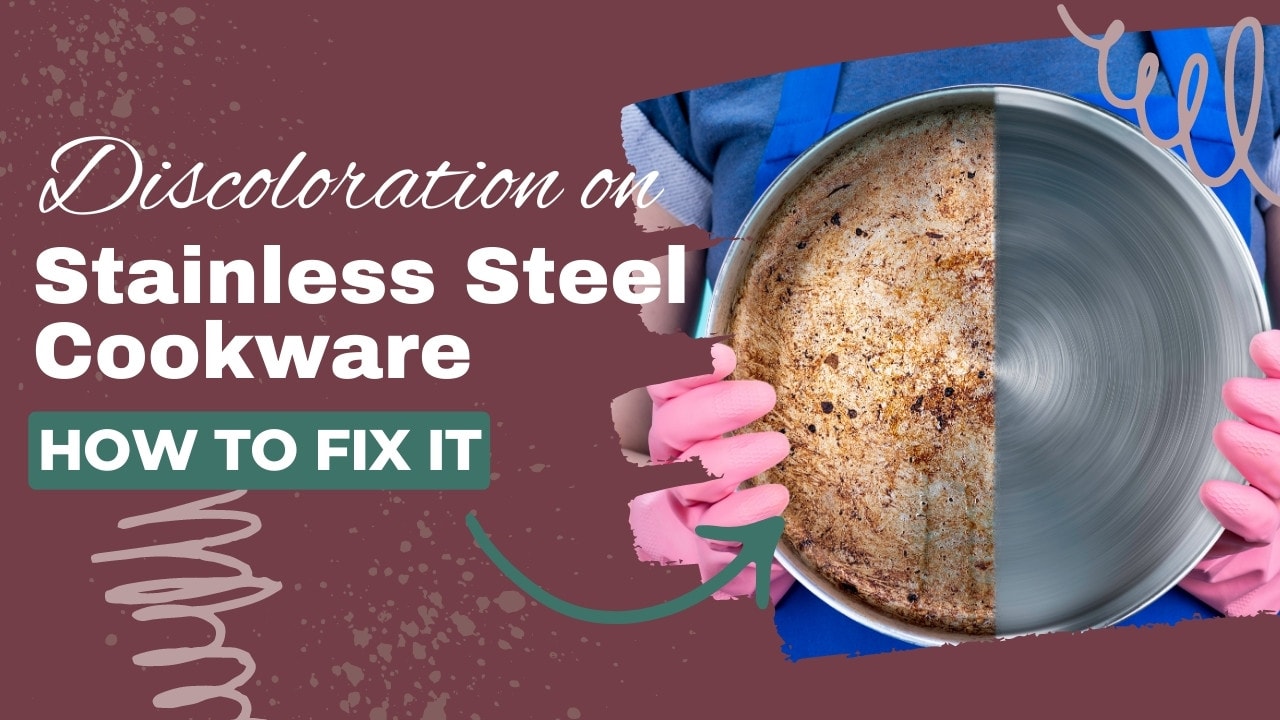When I first bought my stainless steel cookware, I was, like many consumers, under the impression that stainless steel is, as the name suggests, totally immune to discoloration. But after using my pans for a few weeks, I discovered that’s not totally true. Wait, I wondered – did this mean I didn’t get true stainless steel?
So I did some digging. And I discovered that all stainless steel, even top-grade steel, is subject to rainbow discoloration and other forms of “staining.”
But the extent of discoloration depends on the quality of steel. And some forms of discoloration are normal and safe, while others spell disaster for your pots and pans. I am here to guide you through all the variations, so you know exactly what you’re dealing with.
In this article, we are going to dive into the following:
Types and Causes of Discoloration on Stainless Steel Pans
All steel is an iron-based alloy, but stainless steel contains high levels of chromium and nickel. The key that makes stainless steel less susceptible to rust than carbon steel and cast iron is its high chromium content – a minimum of 10%. This is due to a phenomenon called passivity where the chromium in the steel forms a passive layer of chromium oxide on the surface that protects it from corrosion like rust.
A high-quality 3 or 5-ply or “fully-clad” stainless steel pan will be far less susceptible to discoloration than an aluminum or carbon steel pan.
Even so, there are a few ways that stainless steel will discolor that are caused by different factors. Let’s take a look at each form of discoloration and what causes them:
1. Heat Tint/Rainbow Discoloration
This is the most common form of discoloration, and, luckily, it’s totally harmless. To understand why this happens, I have to get into the science.
As mentioned above, stainless steel is made from a composition of iron, chromium, and nickel. When the pan is exposed to air (as it always is), the chromium oxidizes and creates a thin layer of chromium oxide on the surface. Then, when the pan is next used and the chromium oxide layer is heated, it displays a rainbow pattern across the pan’s surface.
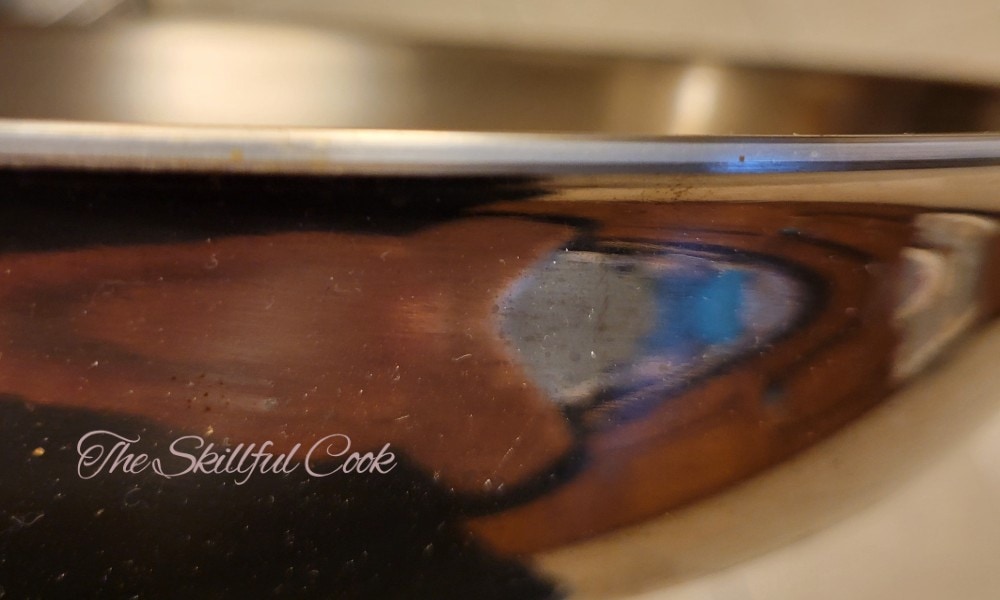
This reaction and the resultant rainbow pattern are not harmful. In fact, it’s this chromium oxide layer that prevents the pan from rusting! But it can be a bothersome aesthetic issue. If you don’t like the look of this rainbow discoloration, there are a few easy ways you can get rid of it. Check out the steps to remove it later in this article.
2. Pitting
While rainbow coloration isn’t bad, the dreaded “pitting” on stainless steel is a form of discoloration that may end in you throwing your whole pan away. It’s important to know what causes pitting so you can avoid it at all costs.
Pitting is a form of corrosion where chloride attacks the layer of chromium oxide on the surface of the stainless steel. This causes small spots that scatter across the surface of the pan. Chlorides are present in salt added to your food and in a lot of tap water. Pitting will most commonly occur when salt has been added to the pan before the water or when a pan of salted water has been allowed to boil dry.
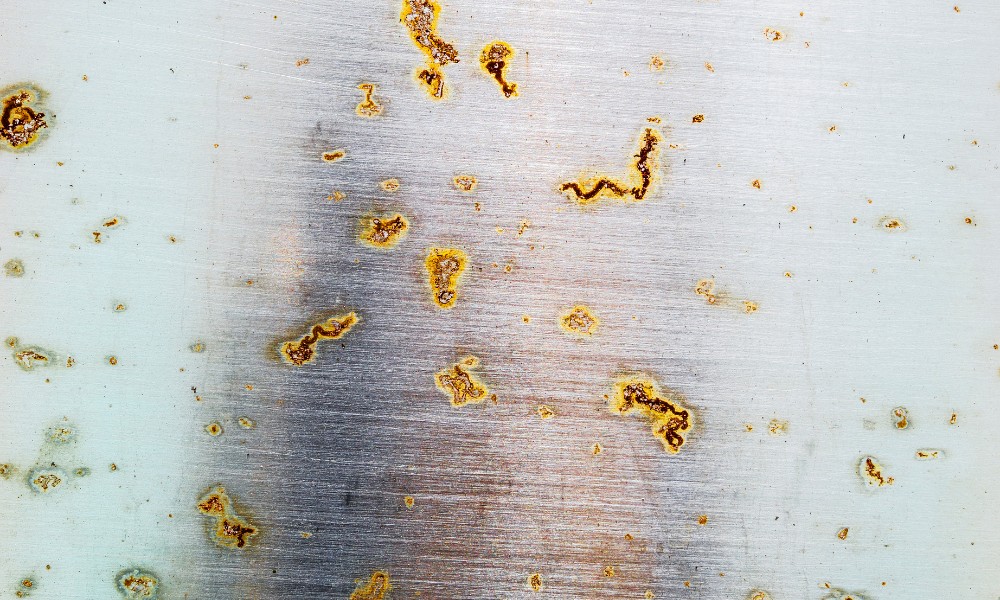
Unfortunately, pitting can’t be easily removed once it has happened to your cookware. (There are electropolishing techniques for fixing pitted stainless steel on commercial machines, but that’s not something you can do at home.) In mild cases of pitting, your pan will reform a layer of chromium oxide and seal over the pitted areas.
However, the corroded surface of pitted stainless steel may harbor food and bacteria, and in severe cases, might expose the aluminum layer of tri-ply pans. Pitted stainless steel could leach aluminum, nickel, or chromium into your food – though opinions seem mixed on whether this happens any more with pitted pans than intact stainless steel pans.
The chances of your stainless steel leaching enough nickel or chromium to be harmful are low – unless you have an allergy to one of these metals – but I recommend playing on the safe side and starting over if you have badly pitted pans.
3. Calcium Deposits
This is a form of discoloration that occurs when hard tap water is used, which contains higher levels of calcium bicarbonate than softened water. When the water is boiled, the calcium bicarbonate will break down into calcium carbonate or limescale; the residue left after cooking causes a cloudy appearance on the surface of your pots and pans.
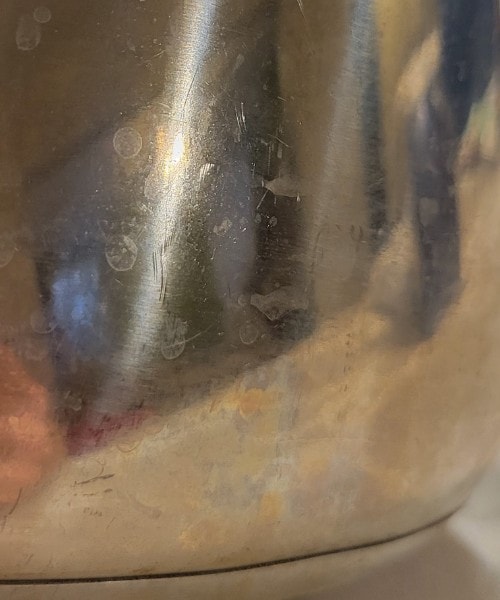
This residue is harmless and, like heat tint, is mostly an aesthetic issue – though it may mildly affect the performance of your pans. If you want to get rid of it, you can use one of the methods that I detail below for getting rid of heat tint.
4. Burnt Food or Oil Residue
If you overheat your stainless steel pan and then use a cooking spray, oil can burn on a pan, leaving a dark residue that’s very difficult to remove. Burn marks are generally safe, but they will affect the usefulness of your pan, so I recommend trying to remove them if possible.
Burnt food residue, especially any stickiness, must be removed before you use it again, as it will adversely affect your pan’s ability to heat evenly, and the nonstick properties of your stainless steel. It can also affect the flavor of the food you cook in it.
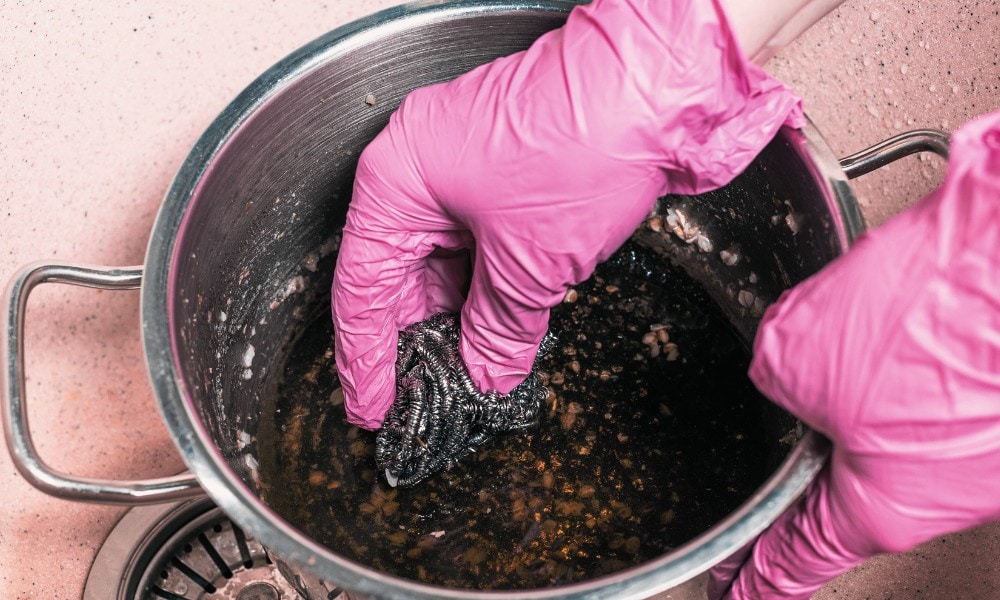
5. Rusting
Rust is always a concern when working with metal cookware, but I need to emphasize that high-quality stainless steel cookware should never rust. The lower chromium content in low-quality stainless steel pans can cause rusting, so I always recommend saving up and investing in a high-quality pan that’s a minimum of 18% chromium.
On fully-clad stainless steel pans, you may encounter rusting around the rivets on the handle where the aluminum is exposed. in bottom-clad pans, the aluminum plate on the underside of the pan may rust.
Rust can be cleaned off using one of the methods listed below, but, again: if you buy a high-quality pan and take proper care of it, you shouldn’t see any rust.
Is a Discolored Stainless Steel Pan Safe to Use?
The safety of a discolored stainless steel pan depends on the nature of the discoloration. Pans with the rainbow effect (aka heat tint) and calcium deposits are entirely safe, and you only need to remove these discolorations if they bother your aesthetic sense.
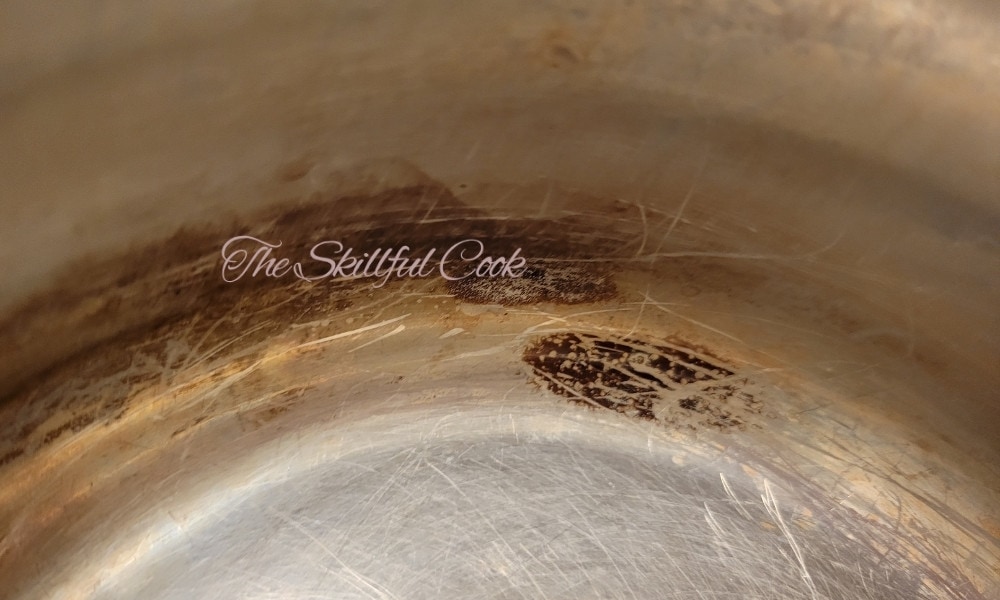
Even pans with burn marks are generally safe to cook with, though you may have concerns about ingesting burnt food or oxidized oil.
How to Clean Discolored Stainless Steel Pans
So, now that we are well acquainted with the different forms of discoloration, we need to figure out how to fix the issue. Luckily, when it comes to heat tint, there are many easy ways to get rid of it.
Here are my top methods for removing rainbow discoloration from stainless steel pans:
Natural Products
I don’t know about you, but if I can avoid buying a bunch of extra cleaners and use something natural instead, I will always take that option. Baking soda and vinegar are two items I always have in my food and cleaning cupboards for every eventuality.
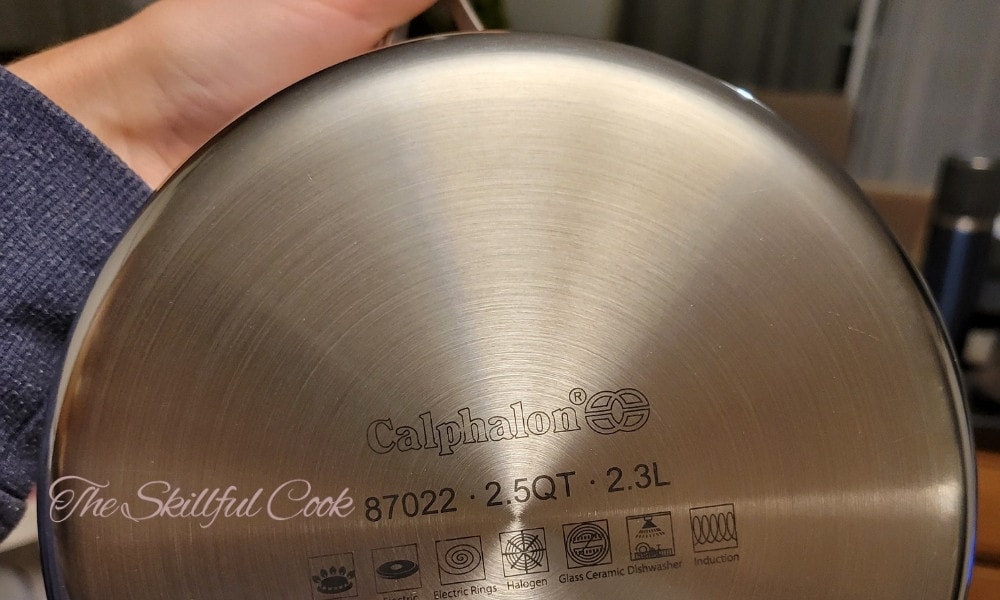
I like using a baking soda paste to remove rust and stubborn burnt food spots, as it’s a really effective yet gentle abrasive. When cleaning heat tint off stainless steel pans, I like to mix up equal parts water and white vinegar and use it to remove the rainbow discoloration. It only takes a gentle scrub with a soft sponge to remove it with this solution.
You can also apply a thin layer of baking soda to the pan and use a lemon to scrub the surface. This combines two powerful natural cleaners to eliminate that rainbow discoloration in no time.
Oxalic Acid Cleaners
My holy grail for multi-use cleaners is Bar Keeper’s Friend. I keep a canister in my cleaning caddy and use it all the time! And yes, it’s not only safe, but very efficient at removing stubborn discoloration on stainless steel pans.
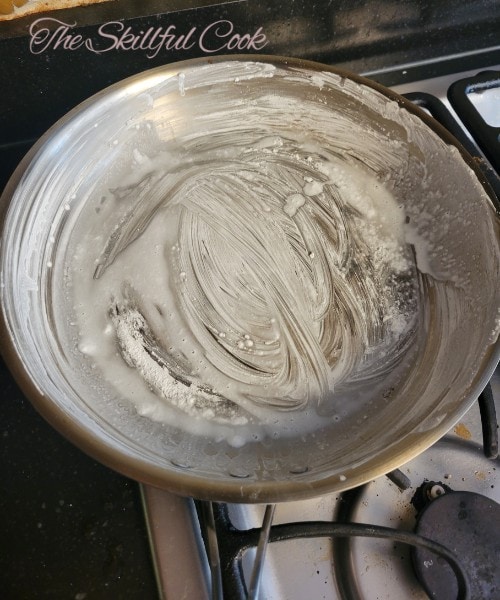
Bar Keeper’s Friend works because it’s an oxalic acid-based cleaner. “BKF” and oxalic acid-containing knockoff products come in powder form and must be activated with water using them on your pans. Swirl some water into your pan and dump out the excess before sprinkling the surface with Bar Keeper’s Friend and scrubbing at it with a gentle brush. (Never use a metal brush on stainless steel pans!) Then use a paper towel to wipe your pan clean. Rinse it out, and your pan should be good as new!
I love how Bar Keeper’s Friend removes the elbow grease from cleaning, no matter what discoloration you’re dealing with.
Other Commercial Cleaners
In the video below, Heritage Steel uses their Stainless Steel Powder Cleanser to get rid of heat tint. It works in a similar way to Bar Keeper’s Friend, but it is not an oxalic acid-based product. Instead, it contains Sodium Bisulfate acid and abrasives quartz and feldspar. It’s very effective and easy to use.
Another commercial cleaner I like for removing rainbow tint is Weiman Stainless Steel Cleaner Polish, designed for both cookware and stainless steel sinks. All you do is add some to a cloth and rub at the affected areas – though you might need to rub pretty hard!
This will clean off burnt patches and rainbow discoloration and polish your stainless steel to a bright sheen at the same time. It does contain oxalic acid, even though the manufacturer claims the formula is pH-neutral.
How Do You Remove Burn Marks or Rust from Stainless Steel Pans?
The methods above are great for removing rainbow tint, but what about the other forms of discoloration on stainless steel pans?
Burn Marks
My favorite way to get rid of burn marks is using baking soda. I sprinkle a layer across the surface of a damp pan and let it sit for 30 minutes before gently scrubbing it with a gentle sponge. Remember, never use steel wool on stainless steel cookware, as it can severely scratch the surface of your pan.
Pitted Pans
Unfortunately, if your pan is pitted, there’s not much you can do about it. The pan’s efficacy will be compromised, and it could be leaching nickel, chromium, and/or aluminum into your food. You may choose to replace pitted pans.
Rust
When it comes to rust, I also usually recommend getting rid of the pan. A high-quality stainless steel pan should not rust, so you need to replace the pan with something better. If there is only rusting on the base or around the rivets of your pan, you can remove them by scrubbing them with Bar Keeper’s Friend, but the rust will likely come back.
Seasoning Stainless Steel Pans
Some people choose not to remove discoloration from their stainless steel and to season their pans instead! If you want to season your stainless steel pans (like you would with cast iron), check out Chef Rich’s demonstration in this video:
Seasoning helps mask discoloration and leaves your pan with a very effective nonstick cooking surface. If you go the seasoning route, you won’t be able to scrub your stainless steel to its original shiny surface after each use, but I think the benefits make this worth it.
For a complete guide on how to season your stainless steel, check out our article here.
How Do You Prevent Discoloration on Stainless Steel Pans?
So now that we know everything there is to know about discoloring on stainless steel, how can we prevent it? Here are a few ways that you can keep your stainless steel pristine:
Tips for Preventing Corrosion on Stainless Steel Pans
- Invest in quality cookware. Buying fully clad and 3 or 5-ply stainless steel pans is the best way to prevent discoloration of any kind. They are less susceptible to these issues, especially rust, so it is well worth saving up and buying a really good pan or set that will last you a long time without discoloring. I’ll add a list of three of my favorite high-quality stainless pans and sets later in this article.
- Avoid using cooking sprays. Sprays like this will coat the pan with a thin layer of oil that will oxidize and burn when heated. This discoloration probably won’t be harmful, but it doesn’t look good, will impact your pan’s performance, and will only get worse with consistent use. Of course, if you choose to season your stainless steel pan, you will want this oil layer, so you can disregard this point.
- Don’t overheat the pan. Even high-quality pans need to be preheated to get a good non-stick surface, but avoid heating it for too long before putting food in it. This can not only cause discoloration, but it can also decrease the longevity of your pans.
- Add salt at the right time. Be sure not to add salt before water or food, as this is a fast track to a pitted pan.
- Avoid scrubbing stainless steel with scouring pads or abrasive cleaners. Some stains are so stubborn that you may be tempted to use something drastic like a strong abrasive or scouring pad, but this can damage the surface of your pans even more. Stick to gentle scrubbing brushes or sponges and gentle stainless steel-appropriate abrasives to maintain the quality of your stainless steel.
- Store it properly. Keep your stainless steel cookware away from humidity and make sure it is not stacked with other cookware in a way that could cause scratching to the surface of your pans.
Conclusion
Discoloration on stainless steel comes in many forms, and while most of them are harmless, they may affect the performance of your pan. You need to identify which form of discoloration you are dealing with to know if you can remove it. For example, rainbow colored heat tint can be easily removed, while pitting is usually permanent. Overall, my favorite product to use is Bar Keeper’s Friend because it can contend with almost every form of discoloration with ease.
What is your best tip for getting rid of discoloration? I would love to hear in the comments!

